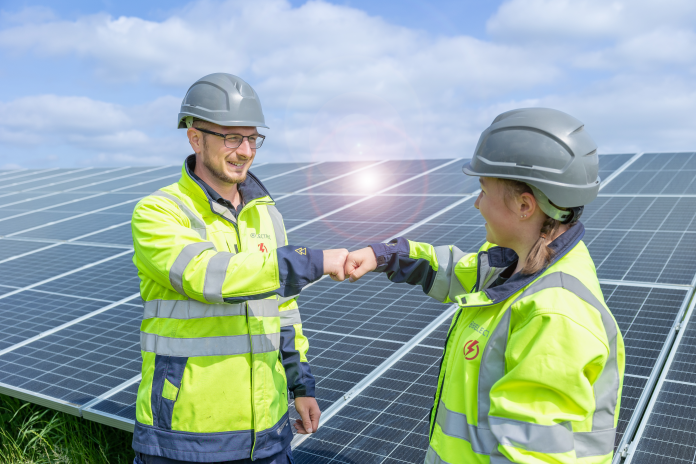Barry Bennett, Managing Director of BELECTRIC’s UK subsidiary, provides insight into the UK’s solar revolution and the key hurdles the energy sector must overcome on the path to achieving the country’s net zero targets
The UK set itself a net zero target to reduce greenhouse gas emissions by 2035. In the process, the government plans to increase solar capacity fivefold by 2035 to a total of 70GW. To find out where the UK’s solar revolution stands on the path to achieving this goal, we should take a closer look at the current situation of the energy transition and the challenges the industry faces.
A company that knows this scenario firsthand is BELECTRIC. BELECTRIC is one of Europe’s leading EPC (Engineering, Procurement, Construction) service providers in the development, construction, and operation of solar power plants. With over 22 years of experience, the company is leading the way in solar and battery storage solutions. Barry Bennett, Managing Director of BELECTRIC’s UK subsidiary, provides his insight.
According to the Department for Business, Energy & Industrial Strategy, it is estimated that only 14GW of solar has been installed in the UK as of 2022, which is a long way from the aspired 70GW in only 12 years. An astonishing 4.67GW would have to be installed annually to reach the goal. Currently, we are only installing 1GW per year on average. A significant push to deliver utility-scale solar farms will be required to support such targets. At BELECTRIC, we know that the UK’s solar revolution faces many hurdles that must be overcome to reach the government’s goals. From our experience, the top challenges are:
Rejected planning permissions:
Between January 2021 and July 2022, 23 solar farms were refused planning permissions across England, Wales, and Scotland. These plants could have produced enough renewable energy to power 147,000 homes. Data from the Department for Business, Energy & Industrial Strategy shows that refusals increased significantly between 2017 and 2022. If we continue to refuse planning permission for solar plants, energy costs will only increase.
Waiting time for grid connections:
The Local Government Association (LGA) has warned that 1,300 green energy projects in the UK have received planning permission but cannot be built due to delays in their grid connections. There is a genuine concern that the net zero target might be at risk. In Dorset, for example, it has become almost impossible for large-scale solar projects to secure grid connections. Some connection dates have been quoted as late as 2036. On average, new grid connections tend not to be possible before 2029.
Lack of skilled workforce for the UK’s solar revolution:
It is a key challenge to ensure that the solar industry has the needed workforce to meet the demand of the net zero targets. As reported by Solar Energy UK, 48% of companies in the renewable industry face difficulty finding the necessary skilled workforce to support the ongoing growth.
Long lead times on essential components:
The industry is experiencing unprecedented long lead times of up to 18 months for some high-voltage equipment and large transformers. Modules and inverters are currently at approximately nine months. Several types of equipment not on the critical path of building a solar farm a few years ago have become critical due to the supplier backlog and scarcity of semiconductor materials. This leads to a delay in project deliveries and puts additional pressure on EPC companies to deliver the projects promptly without compromising the quality.
Limits to agricultural land use:
Under the latest government ruling to protect arable land, only grade 3B land has been determined for its use to build solar farms. This refers to land that can produce moderate yields of a narrow range of crops. However, the amount of land required to support net zero targets with solar installations also using more widely available grade 2 land wouldn’t compromise the security of food supply for the country. Both targets are not self-excluding while sharing the usage of arable land for both purposes.
Environmental, Social and Governance (ESG):
The solar industry faces a significant challenge when discussing ESG around photovoltaic modules, as the raw materials needed to produce them are from China. This might lead to concerns regarding welfare and child labour, as a significant percentage of module manufacturers use silicon wafers produced in a sensitive area of China known for these practices.
At BELECTRIC, however, we only work with tier 1 suppliers who share our values to ensure this topic can be backed by evidence.
Solar energy in the UK
Module efficiency: Solar modules now have an efficiency of around 25-28%, a long way from the 10-20% in the early days of solar.
ROI: The return on investment usually varies between 10-20%, meaning five to ten years of investment payback with a lifetime of 30 years on average.
Weather: Whilst solar works well in the Saudi-Arabian desert, it works just as well here in the UK. Cooler ambient temperatures increase the efficiency of solar modules on sunny days, making the period between April and September especially attractive for solar generation in the UK.
We see that on the path to achieving its net zero target, the UK’s solar revolution faces many challenges. But, with over 22 years of experience in solar power plant construction, BELECTRIC has learned how to overcome them.

This work is licensed under Creative Commons Attribution-NonCommercial-NoDerivatives 4.0 International.











